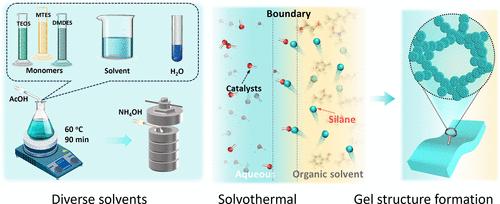不同溶剂热合成多孔聚甲基硅氧烷的微观结构工程
IF 8.2
2区 材料科学
Q1 MATERIALS SCIENCE, MULTIDISCIPLINARY
引用次数: 0
摘要
在溶剂热条件下合成的聚甲基硅氧烷(PMSQ)气凝胶和泡沫具有独特的结构、力学和功能特性。在本研究中,我们以Hansen溶解度参数为指导,在饱和蒸汽压(VP)和温度等可控反应条件下,研究了各种溶剂对粒径分布、孔隙结构和材料性能的影响。多孔PMSQ具有低密度(0.07 ~ 0.11 g/cm3)、高孔隙度(95%以上)、大孔径等特点,具有较高的柔韧性和回弹性。这些特性特别适用于传统脆性气凝胶的不足之处。力学试验表明,颗粒间颈结构和粒径分布对合金的抗压强度和致密化行为有重要影响,颗粒越小,强度和致密化程度越高。多孔PMSQ的疏水表面由硅烷前驱体的甲基赋予,增强了它们的加工和性能,允许在环境压力干燥下保持一致的性能,并使油水分离等应用成为可能。除了机械性能和表面性能外,多孔PMSQ还表现出出色的吸声性能,特别是在2000 Hz以下的低频范围内,初步测试显示,即使在厚度减少的情况下,与聚氨酯泡沫相比,PMSQ的吸声性能也更好。这些发现突出了多孔PMSQ材料在轻质、柔性材料中用于隔音、油水分离和其他先进应用的潜力。本文章由计算机程序翻译,如有差异,请以英文原文为准。

Microstructural Engineering of Porous Polymethylsilsesquioxane via Solvothermal Synthesis in Diverse Solvents
Polymethylsilsesquioxane (PMSQ) aerogel and foams synthesized under solvothermal conditions exhibit a unique combination of structural, mechanical, and functional properties. In this study, we investigated the influence of various solvents, guided by Hansen solubility parameters, along with controlled reaction conditions such as saturated vapor pressure (VP) and temperature, on the particle size distribution, pore structure, and material performance. Porous PMSQ displays low densities (0.07–0.11 g/cm3), high porosity (over 95%), and large pore sizes, resulting in high flexibility and resilience. These properties are particularly suitable for applications where traditional brittle aerogels fall short. Mechanical testing reveals that the interparticle neck structure and particle size distribution play important roles in compression strength and densification behavior, with a trend of smaller particles leading to higher strength and densification. The hydrophobic surface of porous PMSQ, imparted by the methyl groups of the silane precursors, enhances their processing and properties, allowing for consistent performance from ambient pressure drying and enabling applications such as oil–water separation. In addition to mechanical and surface properties, porous PMSQ demonstrates excellent acoustic absorption performance, especially in the low-frequency range below 2000 Hz, with preliminary tests revealing superior absorption compared to polyurethane foams, even at reduced thicknesses. These findings highlight the potential of porous PMSQ materials for use in lightweight, flexible materials for acoustic insulation, oil–water separation, and other advanced applications.
求助全文
通过发布文献求助,成功后即可免费获取论文全文。
去求助
来源期刊

ACS Applied Materials & Interfaces
工程技术-材料科学:综合
CiteScore
16.00
自引率
6.30%
发文量
4978
审稿时长
1.8 months
期刊介绍:
ACS Applied Materials & Interfaces is a leading interdisciplinary journal that brings together chemists, engineers, physicists, and biologists to explore the development and utilization of newly-discovered materials and interfacial processes for specific applications. Our journal has experienced remarkable growth since its establishment in 2009, both in terms of the number of articles published and the impact of the research showcased. We are proud to foster a truly global community, with the majority of published articles originating from outside the United States, reflecting the rapid growth of applied research worldwide.
 求助内容:
求助内容: 应助结果提醒方式:
应助结果提醒方式:


